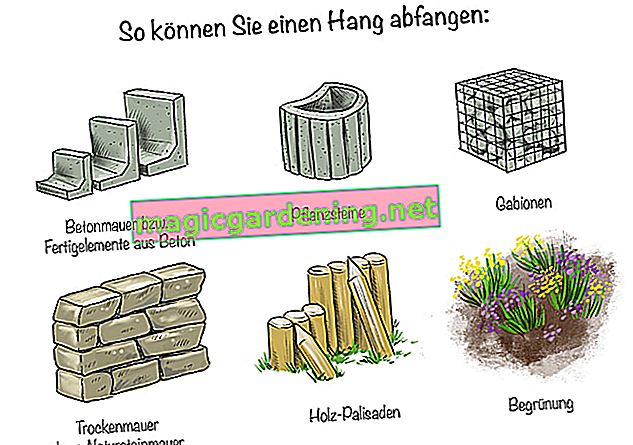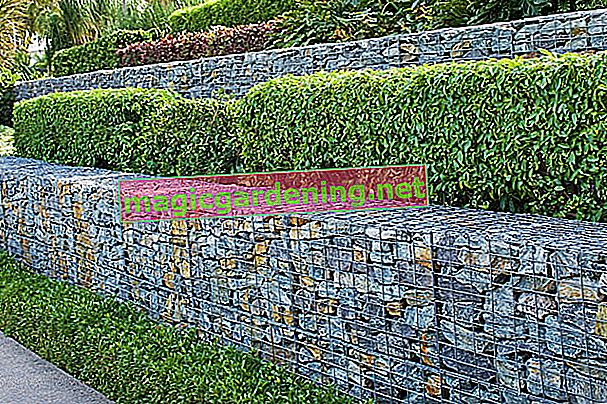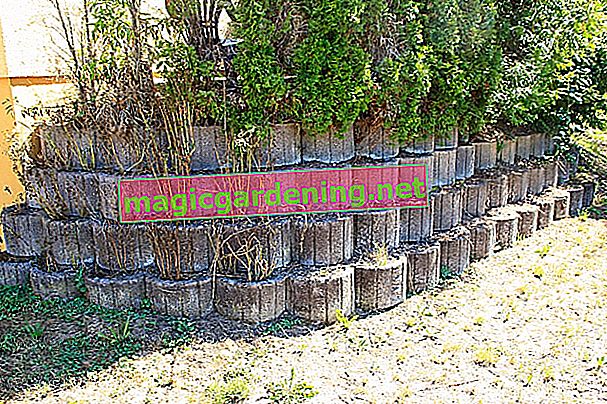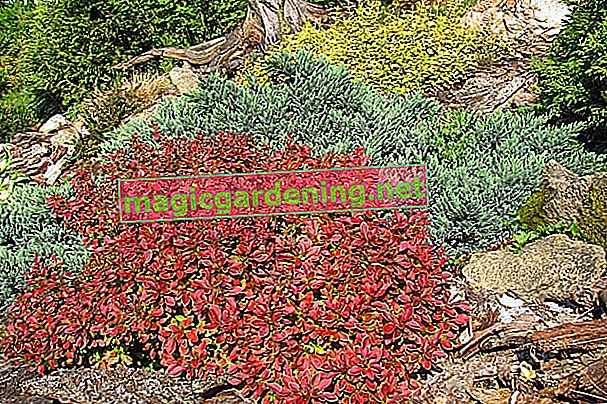
the essentials in brief
- Slopes can be caught with gabions, concrete walls or dry stone walls
- Plants hold slopes and stabilize them
- Streams on slopes look great
Methods of catching a slope
There are a number of options for preventing a slope from sliding down due to erosion and gravity and preventing the property surface from shifting substantially. With cleverly designed interception devices, you can make a sloping garden area particularly attractive and combine the necessary with the beautiful.
also read
- Plant the slope with ground cover
- Plant slopes with easy care
- How to plan and plant a flowerbed on a slope

On the one hand, more or less massive, stone structures are ideal for securing a slope. But a slope can also be compensated with construction elements made of wood or with plants. The most common methods are as follows:
- Heavyweight wall (concrete wall - dry stone wall - gabions - natural stone wall)
- Precast concrete elements
- Plant stones
- Wooden palisades
- Greening
Each of these methods has its advantages and disadvantages and is suitable for different requirements and ideas. Here is a brief overview of their respective properties:
| Gravity wall | Precast concrete elements | Plant stones | Wooden palisades | Greening | |
|---|---|---|---|---|---|
| Suitable for | steep, difficult slopes | heavy, moderately steep slopes | all slopes, additional herb cultivation | flat, easy slopes | wide, flatter slopes |
| advantages | very stable and durable | easy processing, durable | cheapest stone variant, planting option | cheapest option, easy construction | Most ecological variant, decorative |
| disadvantage | expensive, complex construction | Foundation required, sober appearance | not everyone's style | susceptible to weathering, moderate holding power | time-consuming, maintenance-intensive |
Gravity wall
To cushion a steep, long slope, a heavy stone wall is the most solid solution. A so-called heavyweight wall has the necessary weight and strength to counteract the pressure of the slope mass. A heavyweight wall is understood to mean heavy walls made of stone materials - such as those made of solid concrete modules with support feet or masonry variants. The latter include dry stone and natural stone walls.
Concrete wall
A massive concrete wall is usually built from individual modules that flatten slightly towards the top. As a result, they lean against the soil of the slope, so to speak. At the base, the modules have a foot, the thickness of which is about a third of the wall height. About a third of the wall must also be sunk into the ground so that it can provide sufficient stability against the slope.
The wall has to be sunk into a concrete foundation. Drainage is very important for any massive wall that is impermeable to rainwater and meltwater flowing down from the slope. The best way to do this is to build a gravel-filled drainage ditch behind the actual foundation trench, into which a drainage pipe can also be laid.
Alternatively, a heavyweight wall can also be built with formwork blocks. The hollow building blocks to be filled with concrete can be easily built with a tongue and groove system and can already be obtained at relatively low prices. The rules for the foundation and drainage system apply as for a gravity wall made of concrete modules.
Gabions

Gabions have been in vogue for some time - on the one hand, because with their regular wire basket frames they meet the current puristic and geometrically elegant architectural taste. On the other hand, certainly also because they are relatively easy to erect due to the mortar-free filling with loose stones. If they are to be used to catch a slope, however, a solid foundation is extremely important. Because gabions in themselves are not as stable as solid concrete walls. They are therefore only suitable for slopes with a moderate gradient.
In addition to sinking into a deep concrete foundation, drainage is also urgently needed for a gabion wall. Because if water collects and freezes between the loose stones in the wire basket, the wall threatens to tip over due to the load of ice.
Dry stone wall
Dry stone walls are a particularly characterful, mortarless wall variant. Especially in the natural stone wall version, which is built from uncut natural stone. Due to its distribution in the Mediterranean area, a natural stone wall can provide a Mediterranean flair in the garden, especially if a slope is intercepted with several small, terraced natural stone walls.
You don't necessarily need to have a solid background in building a drywall. It is important, however, that when using it as a slope support, you align it with a slight incline against the slope. A deep concrete foundation is also required. A tension cord helps to follow a clear line.
Here is a clear video of a privately built dry stone wall on the slope:
YoutubePrecast concrete elements
Prefabricated concrete elements are modular concrete palisades or L-stones. They are easy to work with, but like gravity walls they have to be set in a concrete foundation. In addition, drainage in the form of a gravel trench at the rear is also necessary here.
Plant stones

A construction from plant stones are not everyone's style. However, a slope can be compensated for in a relatively inexpensive and inexpensive way. In the typical step-like way of processing, which automatically leans backwards, plant stones are ideal for fastening slopes. In addition, they result in a planting area that can be used in a variety of ways - either for a purely decorative green and flower wall or specifically as a herb garden for the kitchen.
However, as with gravity walls, the construction requires a foundation made of gravel and concrete with a drainage device.
Wooden palisades
You can also catch a small slope with “soft” solutions. For example with wooden palisades. The big advantage of them is the uncomplicated processing and the comparatively low purchase price. The disadvantage, however, is that the wooden elements are susceptible to weathering. Despite the impregnation with which they are always provided in view of their destined use in direct contact with the ground, they become modern over time and must then be replaced.
In order to support a slope with wooden palisades, the construction should be set in a foundation trench with gravel and lean concrete.
Greening

Another way to secure a slope is simply a green roof. With their roots, plants can consolidate the pull that sits in the sloping soil quite well. However, this variant is only useful on slopes with a moderate gradient. In addition, the surface of the earth should be provided with a geogrid or an embankment mat made of jute or coconut fibers before planting. This roughly slows down the slipping, but the meshwork gives the plants enough space to stretch out their roots.
A mixture of shallow and deeply rooted small trees and a flat underlay with ground cover is suitable as a firming hillside planting. Supporting and decorative small trees are for example:
- liguster
- Shrub roses
- Buddleia
- Cornelian cherry
- Broom
- Cotoneaster
The following are suitable as ground cover:
- Elven flower (pretty and densely rooted)
- Golden strawberry (robust, easy to care for)
- Ivy (hard-wearing, but also very vigorous)
Ideas for landscaping with a slope
You can get a lot out of a garden on a hillside in terms of design. You can often combine the practical with the useful.
Terraces with natural stone walls
The terracing with natural stone walls is certainly a classic. On the one hand you create an atmospheric, Mediterranean flair in the garden and on the other hand you expand the usable area of your garden. Because the resulting leveled areas are easier to plant with most plants. Small-sized terraces can also serve as the basis for half-raised beds.
On the other hand, you can of course set up pleasure areas with lounge furniture or seating groups with a parasol on the leveled terrace. This is particularly useful on sunny south-facing slopes with an attractive view of the country.
Streams

You can also make excellent use of the slope of a slope for watercourses. Soothing splashing and graceful movements of water over a decorative stone bed enhance a garden enormously. In order to build a stream, you basically only need a pond liner, gravel and stone material to weigh down and decorate, plants depending on the greening requirements and a pump - because for a continuous flow, the water arriving at the bottom must finally reach the starting point above. For this, bubbling stones or gargoyles are ideal. For example, a small pond can be created below.
slide
Do you have children? How about integrating a slide into the slope? The natural incline of the topography makes it possible to set up a slide without scaffolding - only a staircase should be built next to the track.
frequently asked Questions
How can a slope be caught particularly cheaply?
You can roughly say: all stone solutions are also cost-intensive. Unfortunately, this means that the most solid methods are no longer available for bargain hunters. But if you only have to cover a small slope with a moderate gradient, you can get away quite cheaply with wooden palisades, for example. They are quite cheap to buy and only a little lean concrete and gravel are required for the foundation.
Who is responsible for cushioning a gradient between neighboring properties?
The neighborhood legal situation is often not very clearly applicable to individual cases. This also applies to slopes between neighboring properties. Roughly the following can be said: it must always be professionally clarified whether there is a natural gradient or whether soil was digged off or piled up when the upper or lower garden was created. If an artificial gradient is created by digging or backfilling, the person who caused it always has to bear the work and the costs.
How do you design a slope reinforcement in a modern way?
Wooden palisades and plant stones have a more conventional, dusty character. The current taste in garden architecture demands more clear materials and straightforward, no-frills shapes. With geometrically defined L-stones or puristic gabions, these criteria are definitely met. You can get stylistically matching plantings, for example with box trees and ornamental grasses.
What stabilization methods are suitable for a small slope?
If you only have to catch a small slope with a moderate gradient, you can work well with palisades made of wood or concrete. A small, self-layered natural stone wall is also recommended here.








